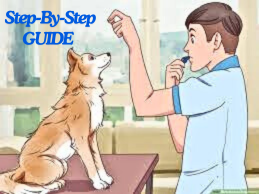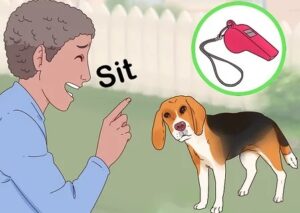Whistle training may be one of the best ways to know if you enjoy your training as much as your dog does, with a clear way of communicating. It teaches you the usage of a dog whistle to train, which not only helps you bond well with your pet but also improves the possibility of desirable behavior from him. This article will cover everything from picking the right whistle to very simple commands on how to train your dog to whistle.
HOW TO USE A DOG WHISTLE FOR TRAINING: STARTING?

A good way to teach your dog commands and make sure you and your dog are communicating is to whistle-train your dog. You may strengthen your relationship with your dog and reinforce desired behaviors at the same time by learning how to use a dog whistle and using dog whistle orders.
Choosing a suitable whistle is one of the first steps in teaching a dog to whistle. Selecting the best type for your needs is important because there are many different kinds available. Once you have the whistle, understanding how to utilize the whistle properly is the next stage. Dogs can easily hear the sound produced by blowing the whistle, which is inaudible to humans.
The first step in teaching a dog to whistle is to associate the whistle sound with a treat or other positive reinforcement. This aids in your dog’s comprehension that the whistle is a helpful signal. Introduce dog whistle commands for particular acts, such as staying or sitting, one at a time. For instance, you could sound the whistle twice to indicate “stay” and once for “sit.” To prevent your dog from being confused, follow the whistle training orders consistently.
Later on in the whistle training process, you can teach your dog more complex whistle commands like heel and recall. Repetition and constructive criticism are essential for success. Never forget to give your dog a treat each time it obeys a command. With repetition, your dog will learn how to whistle train your dog efficiently and respond to the directions swiftly.
Whistle training a dog can be an entertaining and effective way to communicate with your dog. Your relationship with your pet can be strengthened and it will know what’s expected of it if you know how to use a dog whistle and incorporate orders for it. Just keep in mind to apply positive reinforcement consistently and patiently.
HOW TO USE DOG WHISTLE FOR TRAINING: STEP-BY-STEP GUIDE?

Learning how to operate a dog whistle for training is an important skill for every dog owner. Follow these step-by-step guidelines for efficient whistle-training a dog:
Select a fitting whistle: Choose a whistle that your dog can hear but that people cannot hear. Choose the one that best suits your dog’s hearing range among the various varieties that are offered.
Presenting the whistle: When your dog is relaxed and quiet, start by gently blowing the whistle. Make sure your dog can hear the sound by watching how it responds.
Link the whistle to an incentive: Every time you blow the whistle, give your dog a treat or some affection to assist them learn that it’s a good thing. This will contribute to the whistling and favorable associations.
Give your dog these simple whistle commands: Teach basic commands first, such as “sit” or “stay.” Blow the whistle, for instance, once for “sit” and twice for “stay.” To prevent confusion, be consistent in your dog whistle training commands.
Reinforce with treats: Give your dog a treat or some praise when they obey a command. The association between the whistle and the desired behavior is strengthened by this positive reinforcement.
Practice giving your dog whistle commands: Once your dog understands the fundamentals, you may progressively introduce more complex commands. Keep in mind that you should use the same whistle pattern for every order.
Train in a variety of settings: To aid in your dog’s generalization of the commands, practice whistle training them in a variety of settings.
Retain constancy: When training, exercise patience and consistency. Eventually, this will assist your dog learn and retain the orders associated with the dog whistle.
Choosing the appropriate whistle, building strong associations, teaching and reinforcing orders, and practicing regularly in a variety of settings are all important steps in learning how to use a dog whistle effectively. You can successfully whistle-train your dog to obey a variety of orders if you are patient and dedicated.
Read More: How to Train Dog with Shock Collar?
DOG WHISTLE COMMANDS:
Knowing common dog whistle commands is part of learning how to use one correctly. These ten commands are the most common used when trying to teach a dog to whistle:
Sit: Train your dog to sit by blowing once, loudly, and briefly. Follow this with the command so that they do not get confused.
Stay: Train your dog to sit and stay sitting by giving it two consecutive short whistles. This dog whistle training cue should be learned consecutively.
Come: This is very important for the process of teaching a dog to whistle; blow the whistle quickly in short puffs so your dog comes back to you.
Lie Down: You can train your dog into lying down by giving him a long, steady whistling motion. Practice it regularly to ensure that your dog is aware of that command.
Heel: Blow three quick, short blasts on the whistle to make your dog walk beside you. A very useful command in this regard is when walking with the dog or passing through crowded areas. Stand: a dog can be encouraged to stand from a sit or a down by blowing the whistle four times in quick succession; this is quite versatile command.
Off: To get your dog off furniture or to quit leaping on humans, give him a long blow on the whistle, followed immediately by a quick one.
Silent: Each time your dog is noisy or barking, give him two long whistle blows.
Drop it: You can even train your dog to drop everything in his mouth by just blowing a little toot on the whistle and then a long one.
Watch Me: To catch your dog’s eye, blow three long, successive blasts of the whistle and encourage it to look up at you. You are on your way to whistle training a dog if you learn these ten most frequent commands. Teach your dog to whistle with patience and consistency and reward him for his good deeds.
How to Prepare Dog for Whistle Training?
The dog and the owner will prepare before training your dog to whistle. If two parties are well prepared, then the owner will have prepared a good relationship with the dog, and training your dog to whistle will be sure.
About the manager:
You should become familiar with a dog whistle: learn the appropriate way of blowing the whistle, as well as how long to blow for each particular command.
Identify the dog whistle commands: Research and select some specific dog whistle commands that you will want to train to your canine partner. Planning early with the commands ensures consistency during the training process.
Practice patience: since it involves consistency and time. During your dog’s training, practice patience and never lose control easily.
Prepare Reward: Prepare treats, toys, or other kinds of positive reinforcement to reward your dog for properly responding to commands related to dog whistle training.
For dog: Basic Obedience: First of all, you have to make for your dog an underlying basic level of obedience, so when it will be whistle time, all the conventional commands, namely sit and stay and come, easily coincide.
Socialization: The socialized dog is the easiest one to train. Train your dog in many situations with people and other dogs that are going to help make your training sessions comfortable and confident.
Health check: a health check should be done for your dog prior to any form of training because only a healthy dog will have the drive and focus to be productive during training.
Mental stimulation: Use toys, puzzles, or any other cognitively stimulating activity to keep your dog engaged. The chances of getting a mentally active dog to heed your whistle commands are much higher.
Proper preparation of the owner and his dog would make the whistle-teaching process smoother and fun. Improvements in a relationship with one’s pet and the ability to teach that pet how to whistle while giving it commands require time, effort, and positive reinforcement.
Conclusion on How to Use Dog Whistle for Training?
Whistles are an excellent tool when drawing your dog’s attention to you. This is excellent for range, or in highly competitive ambient noise, we discovered while implementing the previous article on “Whistle Training Basics”. There’s a lot of training that could be done instructing the when using it on train commands, but we advise with two train commands when implementing in training time.
The following steps will help you begin the whistle-training process.
Selecting the Appropriate Whistle:
Most whistles work, but we would encourage you to get a whistle that can be heard by a human, rather than one that your dog alone can hear. Silent whistles come in a variety of different frequencies, so first you have to decide which best fits your dog. If it’s audible, it’s very easy to determine whether it works or not.
- Selecting the whistle signals: You have to decide what the whistle sounds are and associate the commands that your dog needs to learn. For instance, the “sit” can be given as a short hit and the “come” as a long hit. Just whatever works for you.
- Selecting the whistle signals: You have to find out which kind of whistling patterns you want your dog to associate with orders. For instance, the “sit” command may be achieved by a short blow while the “come” command may be achieved by a longer blow. It all depends on you on what to use.
- Locating a place free from distractions: When you get the whistle, find a place that has no distractions. It is at this point that the dog will be focused solely on you. There should not be other trainers present at this point. Try to use your yard as much as you can so that the dog becomes well accustomed to the environment. Remember never to forget to take a bag of your favourite treats. Bake a few of the healthy dog biscuits ready to have healthier munchies in.
For the subsequent chapters, let’s consider your dog doesn’t know any command. Now let’s assume you want to give the sit command to your puppy. First, your puppy should start on all fours. Take a goodie in one hand and move it toward the nose of your puppy. Hold your hand out in a gesture for the dog to sit. By bringing the treat closer to the ground, you will be able to accomplish this. It is best if you can give the dog a treat the moment he settles down when you blow the whistle.
For this command, you should make sure that the pattern of blowing is constant. Repeat the above for each session. We will guide you on how to space the training so that it is spread all day for a smooth and productive process. After a couple of days, your dog should be able to respond to the “sit” blowing pattern without the treat.
Read More: 5 Best Dog Shock Collar for Small Dogs
How About the Dog Whistle Other Command?

The requirements are that you must follow the conditions below for training your dog to listen to the other commands.
- Assign a specific blowing pattern to the command;
- Reward the dog with some treat and then make him or her understand that you want him or her to emulate you. You can ask them to come to you or even stop in their tracks.
- Immediately reward with the treat when the puppy has followed the given command and blown on the whistle to make the predetermined blowing pattern.
Concluding the Matter:
As you can see, it is not so hard to teach the dog to operate the whistle. You are prepared for the lesson with goodies and a unique blowing pattern. Of course, the whole training time can be made more appealing if your pet is already accustomed to the commands from your voice.
In Summary:
This will conclude, teaching your dog to whistle is a fun way and very effective in the communication with them. One will grow close relations with his dog and make sure that they learn how to use a dog whistle as well as the commands that must be obeyed sometimes. If you spend just enough time, effort, and positive reinforcements with your dog, then it will not be challenging for you and your dog to be in harmony as the whistle commands.

